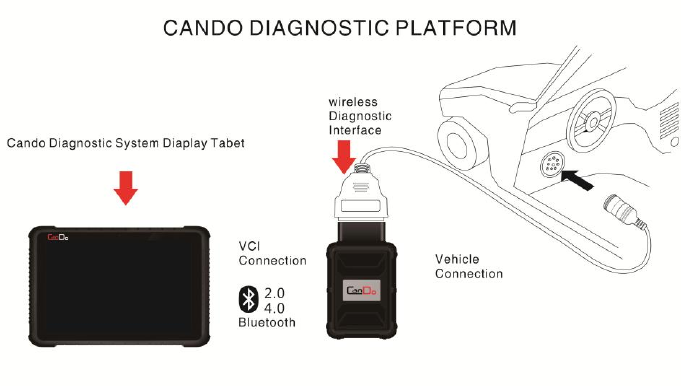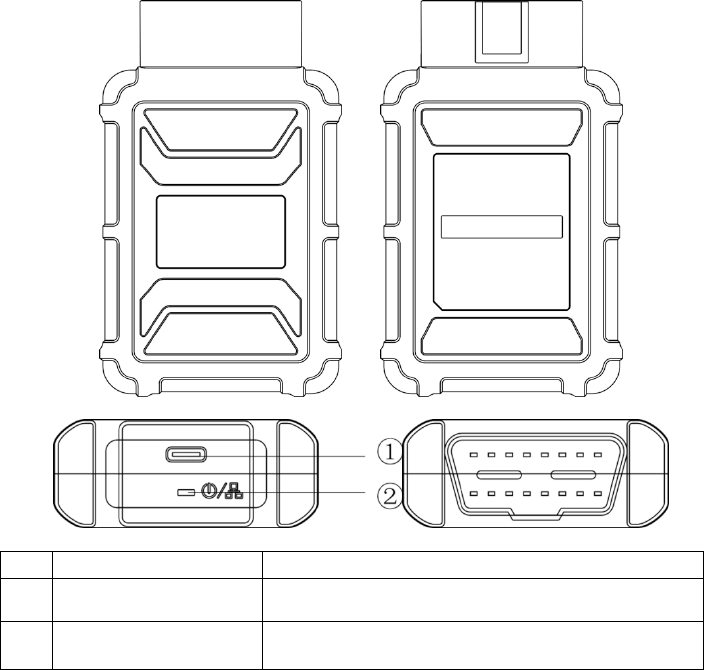User manual
Table of Contents
Table of Contents ................................................................................................................... 1
I Statement ............................................................................................................................... 1
II Introduction ........................................................................................................................ 2
2.1 Wireless Communication ........................................................................................... 3
2.2 USB Connectivity ........................................................................................................... 3
2.3 Power Source .................................................................................................................. 3
III Functional Description .................................................................................................. 4
IV Product Troubleshooting ............................................................................................. 7
4.1 Vehicle Linking Error ................................................................................................... 7
4.2 Firmware Update ......................................................................................................... 11
4.3 Update Online ................................................................................................................ 11
V Compliance Information .............................................................................................. 12
VI Warranty And Service .................................................................................................. 14
I Statement
This manual is designed for the use of CANDO products; it cannot be copied or
stored in any form (electronic, mechanical, photocopying, recording or
otherwise) without prior written permission being secured from
CanDo International, Inc.
This manual is intended for professional vehicle repair technicians.
This manual provides the operation methods for CANDO products only, and
the company accepts no responsibility for the consequences caused by
attempting to use the operation methods on other equipment.
This manual is written in accordance with the existing configuration and
functions of the product, and is subject to change without notice if the
product adds new configurations and functions.
If you have any questions, please contact us by the following ways:
CanDo International, Inc.
Phone: 1-909-CanDo-11(226-3611)
Office: 9431 Haven Avenue, Suite 211, Rancho Cucamonga, CA 91730
www.candointl.com

II Introduction
The Wireless Diagnostic Interface is a multi-brand device which comes with
the CANDO tool kit. It is designed to connect wirelessly with the CANDO
Display Tablet, as a vehicle communication interface (VCI) for vehicle data
transmission. Thanks to the wireless BT technology, with which you are
allowed to work freely around the vehicle.
This interface device can communicate with vehicles’ electronic control
units (ECUs), guaranteeing performance and speed that redefine multi-
brand diagnostics. The development of this interface has been focused on
reducing the communication time, and ensuring the tool is practical to use.
The CANDO diagnostic platform combines the VCI device and the display
tablet with technical information into ensuring quick and simple access to
the vehicle to perform comprehensive diagnostics applications.
2.1 Wireless Communication
The Wireless Diagnostic Interface supports BT communication. It can transmit
vehicle data to the CANDO Display Tablet without a physical connection. The
working range of the transmitter through BT communication is about 300
feet (about 100 m). A signal lost due to moving out of range automatically
restores itself when the display unit is brought closer to the VCI unit.
For detailed information about VCI connection with the CANDO display tablet,
please refer to the CANDO User Manual.
2.2 USB Connectivity
The VCI device also provides a direct connection to the CANDO display tablet
or a PC via a USB 2.0 full-speed connection. All of the electronics are
contained in the device shell, making it a compact and rugged vehicle
communication tool.
2.3 Power Source
The Wireless Diagnostic Interface operates on 12-volt vehicle power, which it
receives through the vehicle data connection port. The unit powers on
whenever it is connected to an OBD II/EOBD compliant data link connector
(DLC).

III Functional Description
The Wireless Diagnostic Interface device includes the cable and user
manual. Please refer to the CANDO User Manual for additional information.
No.
Name
Description
①
USB interface
Connect to tablet PC or upgrade VCI box
②
Diagnostic light
Lights up when connected to vehicle
Lights up when connected to tablet PC
Vehicle Data Connector
The vehicle connector connects the device to the vehicle’s DLC via a standard
DB15 – Pin OBD II cable.
Status LEDs
The status LEDs of the VCI device, which indicates its working status as well as
the hardware conditions, and are very useful for troubleshooting the device’s
communication or connection to the Vehicle, display tablet and/or the PC.
USB Port
The USB port provides the easiest connection between the device and the
display tablet via a USB cable, and is used to control the device from the
software application running on the HD Diagnostic System Display Tablet, as
HD Pro Tab.

Technical Specifications
Item
Description
Communications
BT V4.0
Processor
Cortex-M3 Microcontroller
Frequency
72MHz
Processor Model
STM32F103CBT6
Flash Memory
128KB
RAM
20KB
Wireless Frequency
2.4 GHz
Input Voltage Range
8 V-36VDC
Supply Current
500 mA @ 12 VDC
Operating Temperature
0°C to 40°C (ambient)
Storage Temperature
-20°C to 70°C (ambient)
Bluetooth
Supports Bluetooth 2.0, Bluetooth 4.0
Capabilities
When used in conjunction with the display table, the Wireless Diagnostic
Interface device is able to perform the following functions:
Auto diagnostics to read and clear the error memory, to display
system parameters and the status of the ECU;
Activation, adjustments and configurations that are essential for
ensuring a complete repair;
Resetting the service lights or the airbag systems;
Configuration of the ECUs, keys and remote controls, etc.
IV Product Troubleshooting
This part describes problems that you may encounter while using the VCI
device.
4.1 Vehicle Linking Error
A communication error occurs if the interface device fails to communicate
with the vehicle’s control module when performing diagnostic procedures.
You need to do the following check-ups:
1. Verify that the ignition is ON.
2. Check if the interface device’s OBD II connector is securely connected to
the vehicle’s DLC.
3. Turn the ignition off and wait for about 10 seconds. Turn the ignition
back to on and continue the operation.
Verify the control module is not defective.
If these issues have been addressed, verified, and you are still having trouble,
please contact technical supports for assistance. Refer to the CANDO User
Manual for additional information.
4.2 Firmware Update
CANDO periodically releases updates to the device’s drivers. Updates are
necessary to solve specific problems and to ensure the VCI device is working
properly with the OEM software. If you are experiencing any problems
during use, always make sure that you have the latest device software and
drivers.
4.3 Update Online
This function allows you to update the software for the device through the
CANDO Display Tablet . Make sure the Display Tablet is connected to the
VCI d e v i c e .
V Compliance Information
FCC COMPLIANCE FCC ID: 2AKNY-IDMINIVCI
FCC Statement
This equipment has been tested and found to comply with the limits for a
Class B digital device, pursuant to Part 15 of the FCC Rules. These limits are
designed to provide reasonable protection against harmful interference in a
residential installation. This equipment generates uses and can radiate radio
frequency energy and, if not installed and used in accordance with the
instructions, may cause harmful interference to radio communications.
However, there is no guarantee that interference will not occur in a particular
installation. If this equipment does cause harmful interference to radio or
television reception, which can be determined by turning the equipment off
and on, the user is encouraged to try to correct the interference by one or
more of the following measures:
-- Reorient or relocate the receiving antenna.
-- Increase the separation between the equipment and receiver.
-- Connect the equipment into an outlet on a circuit different from that to
which the receiver is connected.
-- Consult the dealer or an experienced radio/TV technician for help.
This device complies with part 15 of the FCC Rules. Operation is subject to the
following two conditions:
(1) This device may not cause harmful interference, and (2) this device must
accept any interference received, including interference that may cause
undesired operation.
Changes or modifications not expressly approved by the party responsible for
compliance could void the user's authority to operate the equipment.
VI Warranty And Service
Limited One Year Warranty
CANDO warrants to its customers that this product will be free from all
defects in materials and workmanship for a period of one (1) year from the
date of the original purchase, subject to the following terms and conditions:
The sole responsibility of CANDO under the Warranty is limited to either
the repair or, at the option of CANDO, replacement of the device at no
charge with Proof of Purchase.
1)
2) This warranty does not apply to damage due directly or indirectly, to
misuse, abuse, negligence or accidents, repairs or alterations outside
our Service Center or facilities, criminal activity, improper installation,
normal wear and tear, or to lack of maintenance.
3) CANDO shall not be liable for any incidental or consequential
damages arising from the use, misuse, or mounting of the device. Some
states do not allow limitations on how long an implied warranty lasts, so
the above limitations may not apply to you.
4) All information in this manual is based on the latest information
available at the time of publication and no warranty can be made for its
accuracy or completeness. CANDO reserves the right to make changes
at any time without notice.
Service Information
If you have any questions, please contact your local distributor or visit
our website at www.candointl.com
If it becomes necessary to return the tool for repair, contact your local
distributor for more information.